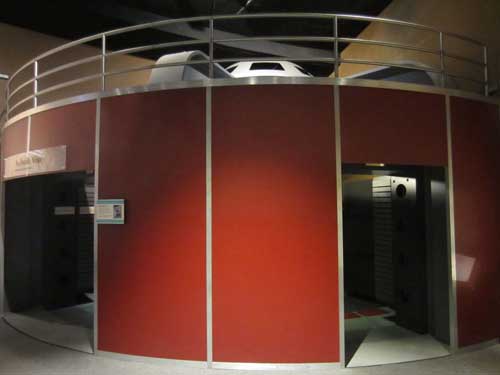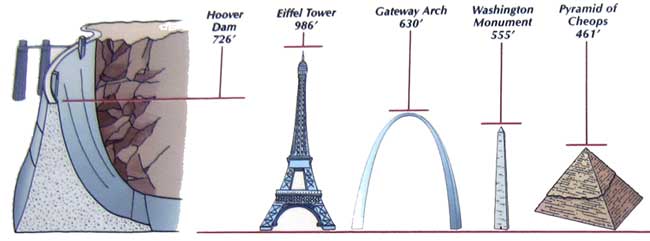So, how to build the dam?
As far back as 1902, surveys were conducted to find the best place to build a dam. Eight potential sites were chosen based on geology, topography, reservoir capacity, depth and speed of the river, distance to train service and distance to southern California (whose power sales would ultimately pay for the dam). After further analysis, only two sites were deemed feasible: Boulder Canyon and Black Canyon.
Original reports favored the Boulder Canyon location (which is why it was originally called Boulder Dam). But the height of the canyon walls were taller in Black Canyon (located 12 miles downstream) and it was also narrower (requiring less concrete) so it eventually won out. Plus the reservoir could be larger.

A few potential locations
Once the spot was chosen, a transportation network was required to get to the remote location. Roads, railroads and tunnels were built. Most of the sand and stone used to make the concrete came from deposits 6 miles away. Telephone and power lines had to be set up across the desert.
Then a design was needed and someone had to build it. It was too large of a project for just one company, so six companies joined together in a partnership.

The lake was named after Elwood Mead (1858 - 1936), pictured here fourth from the right.

One of the first designs for the dam, featuring gigantic eagle sculptures
Next, the river had to be diverted. Four tunnels were blasted through the canyon walls. Tunneling was one of the most dangerous jobs at the dam site... heat (temperaturse could reach 120 degrees F), accidents, carbon monoxide, flooding, electrocution, etc. Despite the difficulties, the tunnels were completed in 19 months, almost 2 years ahead of schedule.

Each tunnel was 56 feet in diameter before being lined with 3 feet of concrete (resulting in a final 50-foot diameter). Nearly 600,000 tons of concrete was used.

To speed up the work, the drilling jumbo was invented. The mobile, double-decker drilling rig would allow 30 miners to work simultaneously. The record was 46 feet in 8 hours.

Three of the diversion tunnels appear as giant holes in the cliffs.
After the river was diverted, the nearly 1 mile of riverbed had to be kept dry, especially during spring flooding. Upriver, a 98-foot tall and 450 foot long coffer dam (earthen dam) was built. Its base thickness was 750 feet (thicken than Hoover Dam's!), It was covered with 3 feet of rock and then 6 inches of concrete reinforced with steel bars. A lower coffer dam (66 feet high with a base thickness of 550 feet) as well as a rock barrier (54 feet high) were built downstream.

Location of the coffer dams (click for a larger version)
Once the site was ready, workers had to excavate 135 feet of mud, silt, sand and rock until they reached the solid bedrock that would support the dam.


Now all was ready to build the actual dam. It involved 3,500 workers per day; 3 shifts per day; 7 days per week. Jobs included blacksmiths, carpenters, cooks, high scalers, miners, welders, chuck tenders (assistants on the drilling jumbo), muckers (removed rock debris after blasting), nippers (ran supplies for the drilling crews) and puddlers (spread the fresh concrete). The hourly wage ranged from 50 cents to $1.25.

One of the original buckets that was suspended from cables and used to haul cement from the on-site manufacturing plants

The dam was built as a series of stacked, interlocking concrete blocks. Water from the Colorado River was sent through a refrigeration plant then pumped into pipes that ran through the concrete forms. They cooled the cement quickly and evenly, preventing cracks.


A piece of the first concrete poured at the dam in 1933 and a section of cable. Ten cableways transported items around the dam. The largest ones (such as this) could carry 150 tons.

Puddlers release concrete into the block form.

Hardhats made from steamed canvas and glue were required for all workers on the canyon floor. This is one of the first instances of their use on a large scale.

How it all works...

Step 1

Step 2

The dam's generators work on the same principles as an electromagnet. A simple electromagnet contains a magnet and wire coils separated by a small gap. As you turn the crank, the magnet spins near the coils, producing electricity. The generator simply has a turbine rather than a crank. Water hitting the turbine causes it, the shaft and the rotor to spin. With a combined weight of over 600 tons, one needs a LOT of water power!

Water flows into the system through a butterfly valve. The wicket gate can open or close, determining how much water passes into the turbine. The water spins the turbine; the turbine spins the shaft; the shaft spins the rotor (magnet) past the stator (wires) and electricity is generated. The water returns to the Colorado River via the draft tube.

This model was built in 1946 to show how the generator works. Note the butterfly valve on the far left and the draft tube on the bottom.

Just for scale, this is a butterfly valve

Dams are categorized according to head, or the difference between the height of the water in the reservoir (forebay) and the level of the water downstream (tailrace). The bigger the difference, the greater the water pressure to spin the generator's turbines. With a head of 500+ feet, Hoover Dam is a medium head dam.

There were many interactive displays.

Test your skill at managing power generation!

A walk-though model of generator

ll that said, it's actually the demand for water, not electricity, that drives Hoover Dam. The water is needed by cities and farmers. The electricity produced is simply an added benefit as the water is released.

Both Davis and Parker Dams downstream are also controlled by the Hoover Dam Powerplant.

Industry, power, drinking water, irrigation, recreation... the dam has permanently changed this area.
There was an observation platform at the top of the visitor center.


A model of the dam

The observation platform

The mighty Boulder Dam! Uh.. Hoover Dam... which is it?
It seemed logical to call it Boulder Dam when it was going to be built in Boulder Canyon. And the name even stuck once it was decided to be built in Black Canyon. However, in 1930 at a ceremony to mark the building of a railway between Las Vegas and the dam site, Secretary of the Interior Ray Wilbur called it Hoover Dam, citing a tradition of naming dams after Presidents (although usually it was when they were no longer in office). In 1933, Hoover was replaced by Franklin Roosevelt and Wilbur was replaced by Harold Ickes. Ickes didn't like Hoover, as was the case with many Americans who blamed him for the Great Depression. Ickes was determined to establish the name Boulder Dam... but it just never took hold. For years, both names were used interchangeably. Finally in 1947, President Harry Truman officially confirmed the dam would be named after Hoover. Ickes, who was by no longer in office, continued to bitterly oppose the change.

Herbert Clark Hoover (1874 - 1964), 31st President from 1929 to 1933

Harold LeClair Ickes (1874 - 1952) served as Secretary of the Interior for 13 years, the longest anyone held the office. He was in charge of the Public Works Administration and the federal government's environmental efforts.


For a better idea of size

Two concrete plants were built on location. The High Mix plant was located where the parking garage is today. Each silo held the equivalent of 20,000 sacks of cement.

One of the last buckets of the Low Mix Plant concrete is dumped. When the dam reached 484 feet high, this plant was shut down. Most of it was moved down river to build Parker Dam, but its foundation still rests at the bottom of Lake Mead.

Each wing of the powerhouse is 650 feet long and 20 stories tall. Half of this height is below the river level.

After rushing through a turbine, water is discharged to the tail bay and back into the river.

Located some 180 feet above the river, the valve houses contain valves that drain the penstocks during maintenance. They also serve as safety outlets in case the spillways can't fully handle a flood.
The electricity produced here travels over thousands of miles of powerlines. To make it that far, the electricity from the generators first gets boost from 16,500 volts to 230,000 volts from step-up transformers...

... which are these silver boxes outside of the powerhouse.

It's then carried via high voltage transmission lines and tower and through power sub-stations to its final destination. Before being sent into a home, the voltage is reduced to 240 volts by a step-down transformer.



Insulators prevent electricity from shorting into the tower or the ground. They are specifically designed for the voltage in the transmission line. Therefore you can calculate the approximate voltage in the line by multiplying the number of segments in the insulator by 14,000.

